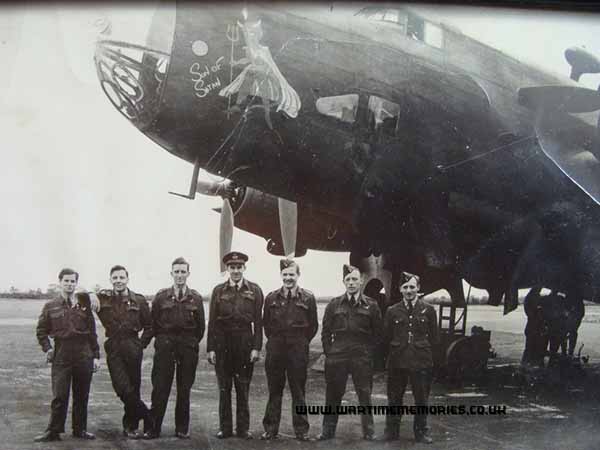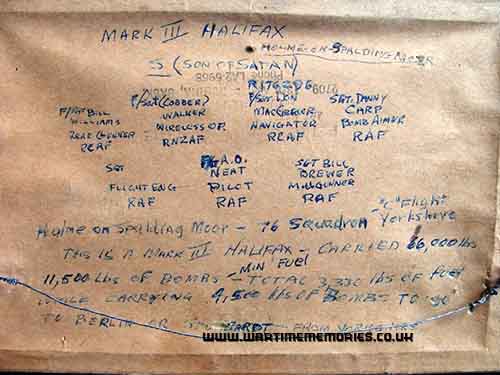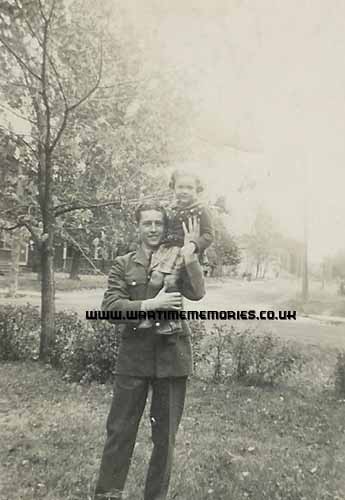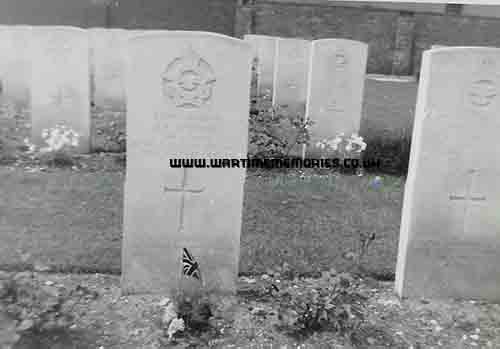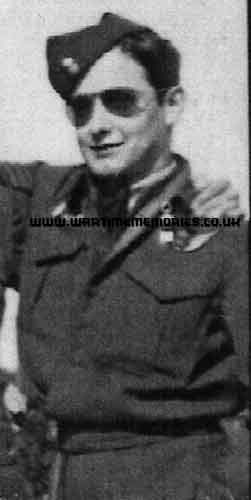|
|
|
Those known to have served at RAF Holme on Spaulding Moor during the Second World War 1939-1945. - Abrahams Aleck. Sgt. (d.21st Jan 1944)
- Beedle Stanley. Sgt. (d.3rd Nov 1943)
- Coates W. Sgt.
- Cummings J. M.. Sgt. (d.3rd Nov 1943)
- Forgan William Wallace. Sgt. (d.9th Jan 1942)
- Forster Malcom D..
- Foster . P/O
- Gadd George Edward. Sgt (d.3rd April 1943)
- Griffiths Lorna. ACW2 (d.17 Jan 1944)
- Harper J. H.. Sgt. (d.3rd Nov 1943)
- Harris Leslie. Flt.Sgt. (d.29th June 1943)
- Harrison Norris Mervyn. Sgt. (d.25th Apr 1944)
- Harveye Ronald George. LAC
- Harveye Ronald George. LAC
- Humphries Reginald George. A/Cpl.
- Jones . Sgt.
- Lohnes B. I.. P/O
- MacGregor Joseph Donald . Flt.Sgt.
- MacPherson F A. Sgt. (d.26th November 1943)
- Masey Jason. AC2.
- Maunders G. F. S.. Sgt. (d.3rd Nov 1943)
- Moore Joseph Howard. WO.
- Moore Joseph Howard. W/O.
- Morgan W. J.. P/O.
- Nelson Henry Montague. P/O. (d.9th Apr 1943)
- Northwood . W/O
- Park James Aloysius. Sgt. (d.24 May 1943)
- Parsons J.. Sgt. (d.3rd Nov 1943)
- Peterson G. E.. Flt Lt
- Poulton C. J.. Sgt. (d.3rd Nov 1943)
- Powis Leslie. Flt.Sgt. (d.12th Aug 1944)
- Rasmussen D.. P/O
- Rogers J R. P/O
- Roy J A A. Flt.Sgt.
- Saunders R C. Flt/O.
- Shakespeare N. J.. Sgt. (d.3rd Nov 1943)
- Shaw Eric. Sgt. (d.12th March 1943)
- Smith Arthur Fenton. P/O.
- Smith Arthur Fenton. P/O.
- Taylor Maurice.
- Thomson Arthur S.. Sgt. (d.26th May 1943)
- VanRooyen Carl Frederick.
- Vines DFM.. Geoffrey William. F/Sgt.
- Wall E. G.. Sgt. (d.3rd Nov 1943)
- Walton Frederick. Flt/Eng (d.10th July 1943)
- Wells DFC.. Arthur Charles. Flt.Lt.
- Whittle H R W. P/O (d.26th November 1943)
- Woodbine William. Sgt. (d.3rd June 1944)
The names on this list have been submitted by relatives, friends, neighbours and others who wish to remember them, if you have any names to add or any recollections or photos of those listed,
please
Add a Name to this List
|
|
|
The Wartime Memories Project is the original WW1 and WW2 commemoration website.
Announcements
- The Wartime Memories Project has been running for 24 years. If you would like to support us, a donation, no matter how small, would be much appreciated, annually we need to raise enough funds to pay for our web hosting and admin or this site will vanish from the web.
- 18th April 2024 - Please note we currently have a huge backlog of submitted material, our volunteers are working through this as quickly as possible and all names, stories and photos will be added to the site. If you have already submitted a story to the site and your UID reference number is higher than 263925 your information is still in the queue, please do not resubmit, we are working through them as quickly as possible.
- Looking for help with Family History Research?
Please read our Family History FAQ's
- The free to access section of The Wartime Memories Project website is run by volunteers and funded by donations from our visitors. If the information here has been helpful or you have enjoyed reaching the stories please conside making a donation, no matter how small, would be much appreciated, annually we need to raise enough funds to pay for our web hosting or this site will vanish from the web.
If you enjoy this site
please consider making a donation.
Want to find out more about your relative's service? Want to know what life was like during the War? Our
Library contains an ever growing number diary entries, personal letters and other documents, most transcribed into plain text. |
|
We are now on Facebook. Like this page to receive our updates.
If you have a general question please post it on our Facebook page.
Wanted: Digital copies of Group photographs, Scrapbooks, Autograph books, photo albums, newspaper clippings, letters, postcards and ephemera relating to WW2. We would like to obtain digital copies of any documents or photographs relating to WW2 you may have at home. If you have any unwanted
photographs, documents or items from the First or Second World War, please do not destroy them.
The Wartime Memories Project will give them a good home and ensure that they are used for educational purposes. Please get in touch for the postal address, do not sent them to our PO Box as packages are not accepted.
World War 1 One ww1 wwII second 1939 1945 battalion
Did you know? We also have a section on The Great War. and a
Timecapsule to preserve stories from other conflicts for future generations.
|
|
Want to know more about RAF Holme on Spaulding Moor? There are:26 items tagged RAF Holme on Spaulding Moor available in our Library There are:26 items tagged RAF Holme on Spaulding Moor available in our Library 
These include information on officers, regimental histories, letters, diary entries, personal accounts and information about actions during the Second World War. |
|
Sgt. C. J. Poulton 101 Sqd. (d.3rd Nov 1943) Sgt C.J.Poulton died when Lancaster LM635 SR-H was shot down on the 3rd of Nov 1943, flying from Ludford Magna en-route to Dusseldoft was shot down. He is buried in the Rheinberg War cemetery.
|
Sgt. J. Parsons 101 Sqd. (d.3rd Nov 1943) Sgt J.Parsons died when Lancaster LM635 SR-H was shot down on the 3rd of Nov 1943, flying from Ludford Magna en-route to Dusseldoft was shot down. He is buried in the Rheinberg War cemetery.
|
Sgt. J. M. Cummings 101 Sqd. (d.3rd Nov 1943) Flew with the crew of Lancaster LM635 SR-H which was shot down on the 3rd of Nov 1943 from Ludford Magna en-route to Dusseldoft.He rests in the Rheinberg War cemetery.
|
Sgt. E. G. Wall 101 Sqd. (d.3rd Nov 1943) E Wall was killed along with the rest of the crew of Lancaster LM635 SR-H on the 3rd of Nov 1943 flying from Ludford Magna en-route to Dusseldoft. He is buried in the Rheinberg War cemetery.
|
Sgt. N. J. Shakespeare 101 Sqd. (d.3rd Nov 1943) Lost his life along with other seven crew of Lancaster LM635 SR-H on the 3rd of Nov 1943 flying from Ludford Magna en-route to Dusseldoft. He is buried in the Rheinberg War cemetery.
|
Sgt. J. H. Harper 101 Sqd. (d.3rd Nov 1943) Sgt J.H.Harper was killed on the 3rd of Nov 1943 when Lancaster LM635 SR-H flying from Ludford Magna en-route to Dusseldoft was shot down. He is buried in the Rheinberg War cemetery.
|
Sgt. G. F. S. Maunders ABC operator 101 Sqd. (d.3rd Nov 1943) Sgt G.F.S Maunders was the 8th crew member (ABC operator) of Lancaster LM635 SR-H was killed on the 3rd of Nov 1943 when the aircraft was shot down, flying from Ludford Magna en-route to Dusseldoft was shot down. He is buried in the Rheinberg War cemetery.
|
Sgt. Stanley Beedle 101 Sqd. (d.3rd Nov 1943) My uncle, Stanley Beedle, aged 23 was shot down in a Lancaster over Germany in 1943, his date of death is 03/11/1943. He was based at Holme on Spalding Moor, 101 bomber squadron. He is now at rest in the Rheinberg war cemetary. Any infomation about him, his plane ,anything ,would be greatfully received.
Update:
Lancaster LM635 SR-H took off at 17:11 on the 3rd of Nov 1943 from Ludford Magna en-route to Dusseldoft. The aircraft was shot down and crashed in the vicinity of Manchengladbach, where all the crew were buried on the 6th of November 43. Subsequently they were re-interred in the Rheinberg War cemetery.
- Sgt J.M.Cummings
- Sgt S.Beedle
- Sgt E.G.Wall
- Sgt N.J.Shakespeare
- Sgt J.H.Harper
- Sgt G.F.S Maunders (ABC operator)
- Sgt C.J.Poulton
- Sgt J.Parsons
|
Maurice "Mo" Taylor rear gunner 458 Sqd. Mr Taylor is a very long standing family friend, he is now 86 yrs. old, over the years he has told me many things about his wartime years.
He joined the RAF in 1938 and served with various units - 458, 460, 150 and possibly others. Holme on Spalding Moor, Molesworth, Binbrook are bases he remembers in the early part, flying in Wellingtons as a rear gunner. At this point in time he was shot down to which even today he finds hard to come to terms with and at the same time I would not press him to talk about. Beyond this point he served in Ceylon on various sqd's until 1946. I would love to find out more as the tales he tells me never cease to amaze me
|
LAC Ronald George Harveye 76 Squadron My father LAC Ronald George Harvey was at Holm-on-Spalding-Moor for part of the second world war with 76 Squadron. He joined in 10/4/1940. He was also at Leconfield and RAF Cosford. In March 1945 he was sent to the Middle East and discharged on 18/12/45. My father died in 1996 and I have his RAF records. If anyone is still alive who knew him or can give me any more information on him and his service I would be very grateful as I am researching my family tree.
|
LAC Ronald George Harveye 76 Squadron My father LAC Ronald George Harvey was at Holm-on-Spalding-Moor for part of the second world war with 76 Squadron. He joined in 10/4/1940. He was also at Leconfield and RAF Cosford. In March 1945 he was sent to the Middle East and discharged on 18/12/45. My father died in 1996 and I have his RAF records. If anyone is still alive who knew him or can give me any more information on him and his service I would be very grateful as I am researching my family tree.
|
Malcom D. Forster 76 Squadron My Father, Malcom D. Forster flew with 76 Squadron, his aircraft was named Der Federmous. He flew out of the Holme on Spalding Moor base from March 1944
through to May 1945. He did a total of 37 sorties.
The the crew were: - Pilot - F/L G.E. Peterson
- Navigator - P/O D. Rasmussen
- B/A - P/O B.I. Lohnes
- W/OP - W/O Northwood
- Eng - Sgt. Jones
- R/G - P/O Foster
- M/UG - P/O M.D. Forster
|
Sgt. William Wallace Forgan 458 Squadron (d.9th Jan 1942) At 04:35 hours on the morning of 9th January in the winter of 1942, Wellington R1785 of 458 Squadron, Royal Australian Air Force took off from the Holme on Spalding Moor air base in East Yorkshire.
Their mission was to join with 30 other bombers to bomb the port of Cherbourg in occupied France to mount a diversion for a larger group of 131 RAF bombers that were assembled and dispatched to the French harbour of Brest. Their mission was to find and destroy the German pocket battleships, the Scharnhorst and Gneisenau that had survived over 60 similar bombing missions from March of 1941.
On board Wellington R1785 were flying officer Bernard Hickey, a 28 year old from Brisbane, his 24 year old co-pilot, Vic Johnstone from Lockington, Victoria, front gunner, William Wallace Forgan, a 22 year old from Crystal Brook in South Australia and Bob Birnie, 24, bomb aimer and observer from Auckland, New Zealand. In addition to these flying ANZACS were 2 RAF airmen, Fred Hinton, a 21 year old rear gunner from Leicester, and Albert Austin, wireless operator from Birmingham in the UK.
Weather conditions over the Normandy peninsula that January morning were appalling, snow was falling, visibility was negligible and to make matters worse the German flak was particularly active. Only three of the 31 aircraft were able to drop their bombs and many were forced to turn back. Of the three Wellingtons from 458 Squadron that left Yorkshire that day only one returned home to base. Wellington Z1312 was hit by flak but managed to reach England with its load of bombs intact but crashed in Dorset after hitting high tension lines killing 4 of its Australian crew with only the pilot and co-pilot surviving.
Wellington R1785 disappeared completely and never returned to Holme on Spalding Moor. The log books of the crew were signed off in red ink with the notation “Operations as ordered, but failed to return”, next of kin were notified of their son’s or husband’s fate with the sorrowful telegram “Missing in Action,” and personal possessions were returned home.
The fate of R1785 and the crew remained a mystery to relatives for over 66 years until Georges Dennebouy, an Air France captain began to research a war time incident which happened on his family’s farm at Colomby in Normandy. In time, Georges teamed up with three other researchers, Mickael Simon, Claire and Claude Letallier who had started to unravel the mystery a decade earlier by interviewing and recording the accounts of eye witnesses of hundreds of pre D-Day aircraft crashes over Contentin in the department of La Manche.
It was in the winter of 1942 that Georges' grandmother along with other locals saw a plane in flames flying at low altitude over Colomby before it crashed into a snow covered field before dawn. Together with other inhabitants they were on the scene before the Germans but were powerless to do anything as the aircraft was on fire except for the tail section and were not helped when German soldiers roughly made them leave.
Two days later the Germans requisitioned 2 local farmers a teenager, Joseph Anquetil and Mr. Auguste Mulot a veteran of The Great War to recover the bodies of the aviators and place in the coffins provided by the occupying forces. The bodies were awfully calcined except for the young blond haired tail gunner who remained trapped in his turret, the floor strewn with lolly wrappers, testament to the loneliness of a rear gunner’s station. Mr. Anquetil remembered very well the military honours given to the victims by the German soldiers who presented arms and who also had this scene filmed by a cameraman.
A few days later, a group of Germans began to salvage parts of the plane, but to their horror they discovered that the plane still carried its 8 bombs of 250lbs. Bomb disposal experts were called in to detonate the bombs and the enormous explosion volatized the Wellington with one of its engines leaping well over 100 metres as a result.
The Germans then made a macabre discovery when they found a sixth body under a wing and ordered yet another inhabitant, a youthful Roger Blestel to remove the seriously mutilated body and place it in a coffin. This proved to be the body of Wally Forgan the front gunner who is presumed to have attempted a parachute jump, as he was hung on the wing at the end of his suspending rods that somehow snagged the wing as the plane made its fiery descent.
In 2005, the group of amateur aviation historians undertook a ground search of the Breul farm crash site to confirm that the wreck was indeed a Wellington and to match the crash to the graves of 6 allied airmen buried in the old Cherbourg cemetery. Using a metal detector Claude Letallier recovered various fragments of aircraft and located a part of the airframe’s distinctive geodectic design bearing a serial number which was sent to the British Aviation Archaeology Council for determination. The BAAC confirmed that it was from a Vickers Armstrong Wellington.
Their search took a new twist when amongst the innumerable boils of recovered twisted metal there was a silver ring. Clearly it was not a French ring but a Sterling silver ring of the Commonwealth bearing what appeared to be the initials of one of the unfortunate crew. But the initials in flowing script LMM did not match those of R1785 crew members; maybe it bore the initials of a girlfriend or fiancé? For three months emails and letters flowed between France, Australia and the UK trying to solve the riddle, when one day Mickael Simon reversed the piece of contorted metal and saw the initials of “WWF’. Overcome with a rush of adrenalin and emotion, they had found the proof they were looking for. The ring once worn on the right hand of William Wallace Forgan confirmed that this was the crash site of the 6 airmen whose remains lay in Cherbourg.
Emotions ran high on the other side of the world when the Forgan family was contacted in Mount Gambier, South Australia and were sent photographs of the ring and were further astounded to hear that the French researchers vowed to return the ring in person within the year.
Georges and his colleagues in turn, were also surprised to learn that David Johnstone, a nephew of Vic Johnstone and Nick Hayes, a great nephew of Wally Forgan had flown together in skies far less hostile for an aviation company in the Northern Territory and unaware that 60 years earlier, their relatives had also forged bonds in the skies over Europe.
The promise made by the French team was honored in March 2006 when Georges Dennebouy and his wife Liliane flew to Australia with the express purpose of visiting the Hickey family in Brisbane, the Forgan family in Mount Gambier and Adelaide and the Johnstone family in Lockington, Victoria where they were welcomed by three of Vic Johnstone’s siblings.
At an emotional gathering in Adelaide, Georges returned the ring back home to the Forgan family and it was here that yet another coincidence occurred. Fred Hinton, the RAF air gunner’s late sister had migrated to Adelaide after WWII and a nephew and a niece of Fred from Leicester were also present and part of the informal ring ceremony.
The dedicated work of Georges, Mickael, Claire and Claude gave closure to a number of families in Australia, NZ and the UK. It rekindled contact between the families of the air crew and brought back the times when the parents of the lost crew corresponded together in hope, refusing to believe that their sons were lost until they failed to return home to Australia after hostilities ceased. This correspondence continued until this grieving generation died out.
At his Adelaide reception, Georges said that their work was unfinished. “It is out of respect and gratitude to these young people who came from far away lands we carried out this research.’ “We hope that a memorial to the crew of R1785 and for the many pilots and crews who perished in the air and on the ground of Cotentin will be raised to honour those who died to return our freedom to us’.
In a little over 2 years in early October 2008, a magnificent granite stele was erected in the heart of the tiny village of Golleville (population 160). Relatives of the Australian airmen and Fred Hinton made the pilgrimage to France to attend the unveiling of the stunning memorial bearing the names of all the airmen who perished. On a Saturday afternoon, what appeared to be the entire village, local school children and visitors from neighbouring towns and villages attended a moving ceremony that drew Members of the French National Assembly, Squadron Leader Tramter, RAF, Mayors past and present and other dignitaries to pay their respects to those young men who gave their lives for freedom.
Some of us who listen to the Australia All Over program on a Sunday morning with Ian McNamara may have heard members of the Australian contingent ring in that evening with their emotional account of the day. Tribute was made to the persistence of the amateur research team, the genuine gratitude of the French, their overwhelming hospitality and organizational skills that would equal or surpass the International Olympic Organizing Committee.
The memorial has received other relatives since its dedication and as Georges Dennebouy stated, “This memorial will serve to remind following generations of the enormous sacrifices made by those who came to our aid so far from their own homes and family”
|
Flt/Eng Frederick Walton (d.10th July 1943) I am seeking anyone who may have known my Great Uncle 1436208 Sergeant (Flt. Engr.) Frederick Walton who along with the rest of his crew were reported killed in action when their Halifax V serial LK892 code MP-C from 76 Squadron took off from RAF Holme on Spalding Moor at 2250 on 9/10.08.1943 on Ops to Mannheim when returning home the aircraft was hit by flak and crashed in flames astride a rail line near Pointe de Garennes at Wimereux-Aubenge (pas de Calais), 5 k N of Boulogne. The rest of the crew were as follows;
- 415055 Flight Lieutenant Colin McTaggart Shannon DFC RAAF
- 655439 Sergeant (Air Bomber) Torrance Buchan
- 1129601 Sergeant (Air Gnr.) John Dodson
- 132386 Pilot Officer (W.Op./Air Gnr.) William Claude Ellis DFC
- 113498 Flying Officer (Nav.) Geoffrey Austin Turner
- 928040 Sergeant (Air Gnr.) John Smith (his brother 810792 Signalman Walter Charles who was attached to 12th Indian Inf. Bde. Sig. Sec also died on service).
Frederick was involved in another incident 3 weeks prior to his death during ops to Essen on 25/26 July (aircraft DK148 MP-G Bar), which resulted in the officers receiving the DFC.
The aircraft took off at 22:16 from Holme on Spalding Moor. It lost an airscrew while over the target, which hit the side of the fuselage. The order to bale out was given, but after Sgt Waterman had done so, control was regained and the crew returned to base and crash-landed 04:26. The Halifax was so badly damaged that it was deemed to be beyond economical repair.
the crew were;
- F/L C M Shannon RAAF
- Sgt F Walton
- Sgt V S Shaw
- Sgt T Buchan
- P/O W.C. Ellis
- Sgt E W Waterman POW
- Sgt Dodson
- Sgt E W Waterman was POW at camps 4B/Stalag Luft 3 number 222416
Does anyone know what happened to Sgt Shaw and Waterman? They were not involved with the fateful mission (Sgt Waterman being a POW).
I have the ops records for the crew, which included details of other problematic landings etc. I have also been in contact with family members of CMS & TB.
|
P/O. Henry Montague Nelson 101 Squadron (d.9th Apr 1943) I am trying to find out what happened to my Grandmother's two brothers who died in WW2, Henry and Sydney Nelson. I have managed to find a H.M. Nelson who flew in a Lancaster from RAF Holme on Spalding Moor but as there are only initals and Henry was recorded as being a POW I'm not sure if the H.M. is in fact Henry. I also found a S J Nelson but only going to the grave site listing did I find that it was not Sydney John Nelson. Henry I hope, was in Squadron 101, as Pilot Officer, that was hit by flak, target area but went down on 09/10th Apr 1943. Can anyone help me please?
|
Carl Frederick VanRooyen My father, Carl VanRooyen volunteered for the RAF from Rhodesia and was stationed at Holme-on-Spalding-Moor. He was a ground crew technician, repairing aircraft for bombing missions after they were damaged. My parents met at Sand Hill Farm where my Mom was born. Her name was Kathleen Smith. A pathfinder bomber crashed in one of the farms drainage dykes on take off due to engine failure. My father came to "mop up" and met and married my mom. Consequently my brother and I were born in Salisbury, Rhodesia after the war.
|
Sgt. James Aloysius Park 101 Squadron (d.24 May 1943) Aged 20 years old my Uncle Jimmy Park joined the RAF as a Volunteer Reserve in 1940. In February 1942 he was posted to Ansty were he completed his Elementary Flying Training and was then posted to Paulson, Manitoba, Canada for training. In August 1942 he was taking his Air Bomber Armament Qualification and in the October his Air Bombers Navigation Course.
He returned to the UK and in early May 1943 was at Lindholme 1656 Conversion Unit before being posted to the 101 Squadron at Holme, Spading Moor. He had three flights before his first ops which was on the 23rd May 1943. After a 9-day break in operations, Bomber Command dispatched 826 aircraft to Dortmund in the Battle of the Ruhr. Uncle Jimmy was part of the crew of Lancaster W4919 which took off at 10:30pm and was later shot down by a night fighter at 02:33 at Bergen, four miles into Holland. All the crew were killed on their first ever mission. He was buried in the military cemetery at Venlo and later interred at Jonkerboos.
|
Flt.Sgt. Leslie Powis 76 Squadron (d.12th Aug 1944) Leslie Powis was my Mum's brother. He joined up after his best buddy was killed along with all his family when his home in Barnsbury Road, Islington, London was hit by a bomb. There is still a green area where the house once stood.
He was lost on 12th August 1944 at 21:44 while flying from RAF Holme on Spalding Moor to Russelheime Opal motor works. He was shot down at Quint Germany near the French- Luxembourg border.
He was flying a halifax MkIII Serial# LW695
The crew on that fateful night were.
Flight Lt. O. R 'Ron' Cramer Pilot (Kiwi) commemorated on the Runneymede memorial, Surrey, England.
Flight Sgt. O. Thomas buried in the Rheinberg War Cemetery 8.G.19, Germany.
Flight Sgt. L.W. Powis commemorated on Panel 212 Runneymede memorial, Surrey, England.
Sgt. C. Astall
Sg. W.B. Collins commemorated on Panel 227 Runeymede Memorial, Surrey, England.
SSgt. K.S. Bolton buried in the Rheinberg War Cemetery 8.G.18, Germany.
Sg. J. Duncan commemorated on Panel 228 Runneymede memorial, Surrey, England.
I would love to see any photos.
|
A/Cpl. Reginald George Humphries 1520 BAT Flight 458 Squadron 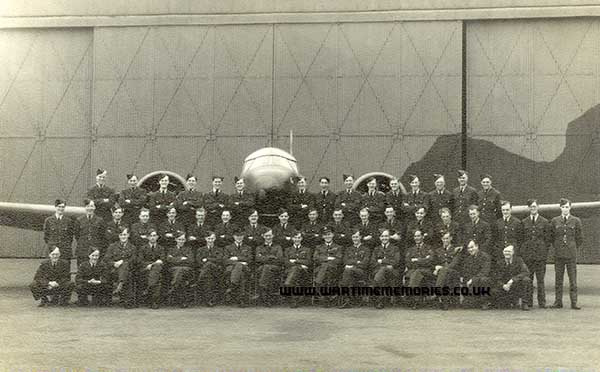 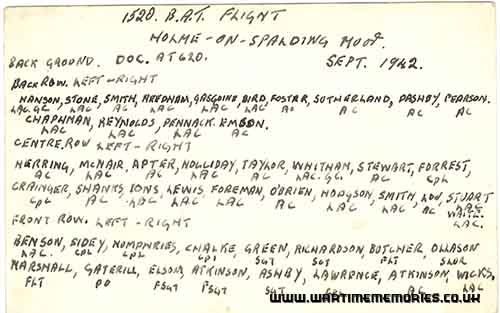 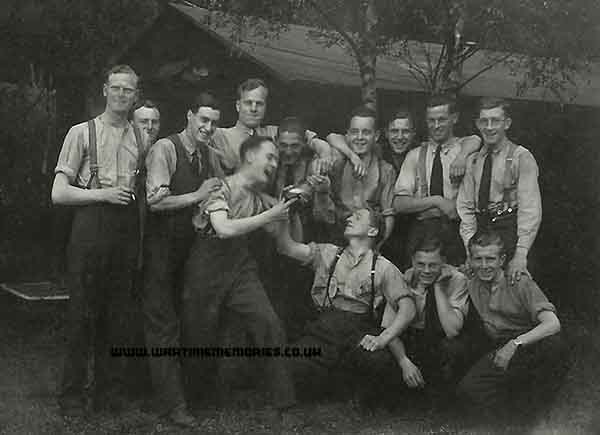 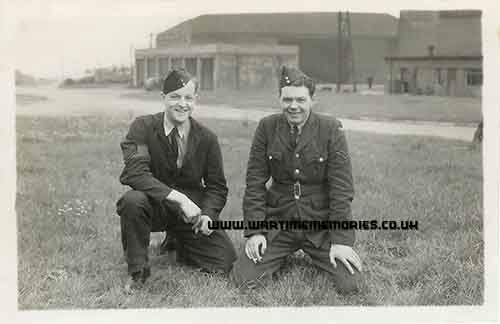 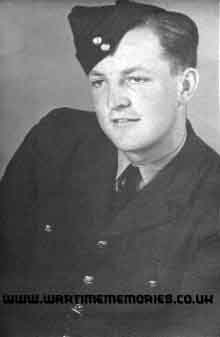 At the end of the course I was posted to Holme-upon-Spalding Moor, 458 R.A.A.F Squadron and was given a travel warrant and a packet of sandwiches, and dropped at the railway station, along with most of the chaps from the course who were all going to different stations. Some were pleased, some were disappointed with their posting. I was pleased as I was going to a Bomber station; but where it was I wasn’t sure.
A visit to the R.T.O.s office soon told me - "Travel to London change to Kings Cross, get a train to Retford, change to Market Weighton and wait for transport."
As it was in the afternoon before we left Hereford, I had a quick trip home and was off the next morning to Yorkshire, which I did not know at the time was to completely alter my life, for here I was to meet the only girl for me & marry her.
I arrived finally at Market Weighton station and phoned the camp for transport and after a very long wait, a small open back truck arrived. By now it was almost dark and the ride back to camp in the back of the truck didn’t give me any idea of the area. On arrival, after reporting to the orderly room, I was shown into a hut and found a bed and told to report to the section in the morning. Next day, after having found the way to the dining hall for breakfast, I found the Electrical section and was soon being shown what my duties were to be (when we had some planes to work on!)
The camp was new, and one of the hangers still hadn’t got a concrete floor, and other parts of the camp were still being worked on. The electrical section shared a small work shop with the R/T section, next door was the Accumulator charging room which came under our care, some time later we had specially trained W.A.A.F.s to run the Acc rooms. The section was made up of a Flight Sargent who had been recalled into the service, one Corporal, 2 Group 1 Electricians and six group 2 Electricians. We were split into two groups, A and B Flight. I was on B Flight and with the three Group 2s, we would be responsible for all the aircraft in B flight (when they came) as well as providing other duties like guard duty and night duty in the Acc room, which was shared with the A flight lads.
After about two weeks, aircraft started to arrive, and it wasn’t long before we had our full strength of 24 Wellington Bombers spread around the airfield. The airfield had been a farm, and as a lot of the fields were still planted with crops, the farmer was often seen gathering up the carrots, turnips, swedes and other vegetables. He was helped by all the lads who could always been seen munching on carrots or turnips while carrying out their various duties on the planes. Being new aircraft there were often alterations or modifications to be made to them. Some minor, while others quite major, which required the planes being put in the hanger. One of the jobs I can remember doing was the installation of a wiring system for the release of poisonous gases, but it was never used. Eventually the Squadron was ready for operations and work started to get into a routine.
It was about this time that the main body of the Australians arrived on the camp, it seemed strange with their dark blue uniforms at first, but as we all wore dark blue boiler suits when working, we soon settled down together. There was the usual rivalry between nationalities but on the whole we got on well. We had some additions to the section, we had our own Fl/Lt Engineering Officer and six more electricians. A typical days work. began when we arrived at the section and checked on work for the day. This depended on any reports of damage, failure of parts from the previous nights raid, any damage sustained etc. This had to be sorted out and the simple tasks passed out to the Group 2s and the larger ones left to myself and the other Group 1. Although we each had a flight, we often worked together on the more difficult jobs, while the Corporal stayed in the workshop, working on parts which could be brought in for repair like starter motors, generators, magnetos, airscrew motors and regulators. Around mid-day, the number of aircraft required that night would be known, and they had to be inspected and tested. These D.I.s (daily inspections) were done by the Group 2s, who set off round the dispersal sites to check each kite. This required checking all electrical equipment on the plane. Lights internal and external, gun sights, bomb sights and bomb gear undercarriage lights, airscrew, starter motors and ensuring the accumulators were fully charged and often this required carrying two new Accs from the Acc room to the dispersal site. Each one weighed 50lb and after a mile felt like 150lbs. Sometimes you could get a lift from a passing truck or hook them on the handlebars of your bike. There was often a last minute panic when one of the kites developed a last minute snag, which require working until it was fixed; often in the dark, with the aid of a torch held in your teeth or wedged against some part of the aircraft.
As well as these duties, it was also our job to lay the telephone cable between the control tower and the end of the runway, to the mobile caravan, layout the 'Glim' lamps alongside the runway, set up the ‘Angle of Glide’ unit and the ‘Chance Light’. This was a 3kw flood light which was self powered by a V8 car engine driving an alternator, and was switched on as the aircraft were about to land so that it lit up the start of the runway and was put out as soon as they had touched down . There was also the ‘Flashing Beacon’; this was a mobile unit, again self-powered like the Chance Light, but this had a small tower about 3ft high fitted with eight neon tubes which flashed the 'Letters of the Day' and indicated to the crews which ‘drome was which. The flare path 'Glim' lamps were small individual lamps designed so that the lamps could only be seen at a low level, so that the pilots knew where the runway was. Each one had to be switched on or off manually, and was powered by a small 6volt accumulator. If it was misty or foggy, we had 'Gooseneck Flares' christened 'Bloody Duck Lamps' by one of the lads. These were like a large watering can filled with paraffin and a piece of rag pushed down the spout into the paraffin and then lit.
You can imagine the panic trying to put these and the Glim lamps out when a enemy plane had followed the lads home and was trying to bomb the camp. Some nights if there were no operations, there would be new crews doing 'circuits and bumps'; practice takeoffs and landings. We also had a B.A.T. flight on the station 'Beam Approach Training’ and they sometime flew at night. This was an early system for guiding the pilot onto the runway. If he was too far left he heard a series of dots, if he was too far right he heard a series of dashes, and if he was on course he heard a continuous note.
The nearest town was Goole about 15 miles away, and could be reached by a bus service which ran from the camp gates each evening about 6.30pm, and leaving Goole about 10.45pm There were two picture houses, several pubs and on Saturdays they held a dance in the Market Hall. There was also a train connection to Doncaster for the adventurous. Evenings were spent either at the pictures or drinking in one of the pubs. There were several ‘dromes in the area so the place was always full of R.A.F. and soldiers stationed in the area. Occasionally there would be some sailors from the Navy, who sometimes came into the port, but always a number of Merchant seamen, which often resulted in a number of fights.
On New Years Eve 1941 there was to be dance on camp, and everyone was going, but it started to snow in the afternoon and by the time we had to go to the dance, it was starting to get thick. We were met at the door by the Discipline Sargent, and told to report to the stores in our working clothes and a draw a shovel. As Electricians we were sent to our section, as all the station was put on clearing the runway of snow, WAAFs were told to help in the cookhouse making sandwiches, and cocoa which was laced with rum and taken out to the runway. We had to go to each aircraft dispersal and get the small Trolley Accumulator starter units, and bring them back to the section, check them and put them on charge. This was done by a small petrol driven generator on each unit. We finished up with twenty of these things all running through out the night. This system lasted for almost three months - snow clearing squads working every night to keep the runway clear. We were the only ‘drome in the area where a fully laden aircraft could get off, so planes from other stations would fly into us to be fuelled and bombed up, before they went on ops, and then returned to their own stations. We were kept pretty busy over this period, checking each kite as it landed and doing any minor snags which had turned up. At this time we were dropping a lot of sea mines off the French coast and these things were electrically fused; so this became our job to connect them up. This went on through January and into February and of course the wind wasn’t always blowing from the same direction, which meant that we had to rollup the phone cable and re-lay it on another runway. Trying to roll up a cable in two feet of snow was not the easiest of things to do! Usually we had the drum held by two men holding a piece of pipe or a crow-bar and the third man turning the drum to roll the cable onto it. Once or twice it was so cold, the Aussies would have to stop and go back to the section and send two more out to finish the job. One morning one of the Aussies said to one of our lads, “Bloody cold this morning mate”, to which the cockney replied “Cold mate? No it ain’t ..... you wait till you see the penguins flying over here, that’s when it’s really cold”. These lads from down-under didn’t like the extreme cold and couldn’t understand us Brits getting undressed for bed. They often went to bed in trousers, pullovers, balaclavas and even their great coats.
Different from the RAF they had permanent 'Room Orderlies', whose job was to keep the barrack room clean, ours was a rough and ready chap called 'Sharky'. The two pot-bellied stoves in the hut were alway red hot (where he got the coal from we never asked!) he always had a large urn of soup bubbling away on the stoves, which used to cost two or three pence for a mess-tin full, very welcome at night. We never asked where he got the ingredients from, but I am sure some of the farmers may have wondered about their chickens disappearing.
At last the snows went and we could get back to normal working, checking the kites for ops, repairing those damaged or due for inspections. These were carried out every 40 hours of flying time. Every aircraft had its own record sheet, Form 700. This had to be signed every day by the various trades who had worked on it certifying that every thing was O.K. The Pilot would check it and sign it before take off. The inspections got more detailed as the flying time mounted up, a 40hr was relatively small and could usually be carried out at the dispersal site; whereas a 120 and 240 would require being carried out in the hanger; while a 360 would be carried out at a maintenance unit where they had bigger hangers and equipment for taking the plane apart so that certain parts could be tested. A lot of aircraft never lasted to undergo a 360 but the 120 and 240 kept us busy.
We got leave from time to time, usually a 48 hr pass once every six or eight weeks; and a 7 day leave every six months. I went off on a 48 and visited some friends of my cousin’s husband. He had been stationed in the outskirts of Sheffield on the Ack-Ack and had met up with these people who invited Gladys to go up and stay there for a while. She and Dink had married in July 1939 and Dink was a Territorial who were called up in August 1939.
I had a pleasant time and was taken around a steel mill and the man I was staying with was one of the managers and had to visit the works on the Sunday morning. When I returned to camp the hut was empty; everyone had gone - they were on embarkation leave, and I wasn’t on the list, so for a few days I was without a unit and spent time packing up the things in the section that had been left behind. After a few days I was told to work in the station workshops until a posting came through for me. So it was back to looking after the Accumulator rooms and any work on the M.T. section that might come up.
By now there were WAAFs in the Acc Rooms, so I only had to keep an eye on things. After a week or so I was posted to the B.A.T. Flight on the ‘drome. We had four Airspeed Oxford aircraft and they flew from dawn to dusk doing circuit and bumps with pilots learning how to use the Beam Approach. Occasionally a strange aircraft would land either by mistake or when their ‘drome was out of action or fog bound, and would need inspecting before they took off for their home base. It was about this time that one night we had an ENSA concert and that is where I saw a very pretty WAAF walking with another girl, and I thought, “What a smasher! I must meet her”, but when the show finished I couldn’t see her, and although I looked, I didn’t see her again on the camp that night.
When the Squadron was on the station we had ordered some equipment for testing generators and voltage control units. They had arrived after the squadron had left, but knowing another would soon be filling their place, it had been set up in the Workshops in the room where they had a large lathe, One day I went into this room to test a generator, and to my great surprise, there bending over the lathe, was the very girl I had been looking for. She was using this large lathe to polish the centre electrode of a spark plug. Needless to say, we soon got talking and before long we were meeting in the evenings. She told me that she and her friend were intending to spend a leave in London, and asked if I could suggest places to see and where to stay. I suggested that my mother might put them up and wrote home straight away, and soon received a ‘Yes’ answer. I suggested that I took a 48 hr leave as well, to show them around a bit. I then changed it to a 7 day leave and as Ivy could leave camp earlier than I could, we would meet on King Cross Station. It was also the day that my name appeared in orders to be promoted to Corporal, so it was round to the tailors to get the stripe sewn on before I went on leave. When I got the Kings Cross, I was busy looking for a WAAF, when a pretty girl in civvies said “Can I help you, Corporal?” Then I realised that it was Ivy in civvies, and I have been in love with her ever since that time I saw her walk into the concert.
We spent all our leave together with her friend who had been posted from Holme, seeing the sights and visiting the pictures to see ‘Gone with the Wind’; and finally going back to camp together.
We were kept pretty busy in the BAT Flight. The planes were up every day from early morning until dusk, this meant that the bigger inspections came around much quicker, it seemed that there was always one of the four in the hanger for a major inspection. We would have at least two 40 hour inspections a week, and a major inspection every month, apart from the day to day inspections and repairs. To simulate night landings, the cockpits were hooded and the pilots had to wear special goggles. The flare path was laid out with sodium lamps (Bright Yellow) which they were able to see, but nothing else; and listening to the dots and dashes of the Blind Approach system they had to land on the runway. After every Major inspection the N.C.O.s of each section had to go up on the air test. One day when we were flying, there was a new Radio corporal up for his first time, and one of the tests was to see if the plane would fly on one engine; the look of horror on his face when he noticed that the port engine had stopped......
“We’re going to crash”, he yelled and made towards the door.
Someone grabbed him before he jettisoned the door and suggested that he had better put his chute on before he left. We quietened him down and persuaded him that every thing was alright.
One of the pilots was a Canadian Sargent, and would let one of us handle the plane for a while. At first it was difficult keeping it level, but after a while we soon got the hang of it.
Apart from the BAT flight duties, I was still called on to keep an eye on some of the other electrics on the camp, like the bomb aimer trainer; this was a two story tower where the bomb-aimers could practice. A bomb-aimers position was on the higher level, while a film camera showed a moving picture on the floor. When they saw the target and pressed the release button, the film stopped and a pinpoint of light showed where the bombs would have fallen.
Reg Humphries
|
Flt.Sgt. Joseph Donald "Mac" MacGregor C Flight 76 Squadron My Dad Joseph Donald MacGregor was a Flight Sargent navigator with 76 Squadron on a Mark III Halifax, Holme-on-Spalding-Moor, in Yorkshire during 1944/45. All I know about his time there is what he wrote on the back of a photograph he had of his bomber, (Son of Satan) and his flight crew. He was sometimes called "Mac" or Don, never by his first name of Joseph. As far as I can make out, members of his crew were:
- F/Sgt Bill Williams, rear gunner, RCAF
- F/Sgt 'Cobber' Walker, wireless op, RNZAF
- F/Sgt Don MacGregor, navigator, RCAF
- Sgt Danny Carp, bomb aimer, RAF
- Sgt ?, flight engineer, RAF
- F/O Neat, Pilot, RAF
- Sgt Bill Brewer, mid gunner, RAF
If there is anyone out there who knew my dad or any of his crew, I would be happy to hear from you.
|
Sgt. William Woodbine 78 Sqdn. (d.3rd June 1944) My uncle William Woodbine was stationed at Holme On Spalding Moor and who lost his life on 3rd June 1944 in a Halifax III bomber over France on Operation Trappas. I am searching for any information I have a few details after this date, i.e his burial site, but would like to know of anyone who knew or had contact with him before he lost his life.
|
Sgt. Arthur S. Thomson ED660 101 Squadron (d.26th May 1943) My Great Uncle, Sgt. Authur S. Thompson From Newcastle Miramichi, New Brunswick, Canada served with 101 Squadron. His crew flew out of Holme on Spalding Moore on the night of 25th of May 1943 and crashed/was shot down?? near Cromvoirt, Holland on a Dusseldorf bombing run. Six 6 of the crew lost. They included all of those listed below. His death was listed as 26th of May 1943. I would like to find out more about what happened as my Father thought the crew may have been captured after crashing/bailing out and then shot by the Germans. Any information would be of great interest.
Records state: 101 Sqd Lancaster III ED660 SR-U took off from Holme on Spalding Moor on Ops to Dusseldorf, crashed near Cromvoirt Holland, those killed are buried in Uden War Cemetery, Holland.
- Sgt. Ainsworth B C. 1079641
- Sgt.
Bates C W. 1586116
- Sgt. Berresford D L. 1211846
- Sgt.
Shackleton E. 1507344
- Sgt. Thomson A S. R112455
- Sgt. Tindale V J S. 1480799
|
Flt.Sgt. Leslie Harris 76 Squadron (d.29th June 1943) Although already in a Reserved Occupation, my father volunteered for the Royal Air Force and was posted to South Africa to undergo training as an Observer. He gained his Observer Brevet in 1942, returning to England that same year.
With a 10 O.T.U. detachment flying Whitley Mark 5s out of St Eval, he helped to track and bomb U-Boats. Apparently, one took offence at this treatment, after being caught on the surface, and promptly fired a shell, blowing a hole in the starboard wing of their machine. Later, still with 10 OTU, returning from a sweep, their aircraft suffered an engine fire. The pilot instructed the crew to take to their parachutes, thus saving their lives. Bravely staying at the controls the pilot lost his life in the crash. Suffering a fractured ankle and gaining his Caterpillar Badge from the Irving Parachute Company, my father spent some time in hospital before being transferred to 1658 HCU at Riccall in Yorkshire, converting to the Halifax bomber.
From there he was posted to No. 76 Squadron then at Holme-upon-Spalding Moor. On the evening of the 28th June together with his crew, in Halifax Mark 5 MP-R DK137 took off for Cologne. The aircraft failed to return, having been shot down by a night fighter with the loss of the entire crew.
|
AC2. Jason Masey 76 Squadron At one period of my training for Aircrew Duties (PNB) the Flight of 50 trainees I was in was attached to 76 Squadron at Holme on Spalding Moor from November 1944 to February 1945. I was attached to Armoury A Flight. For most of my time with them I was assigned to assist with the 'bombing up' of the Halifax Aircraft. One particular incident I remember, apparently there had been some problems with bomb release, resulting in partly failed missions. We were given the task of fitting a bowden cable to provide manual release of bombs and their carriers. The Release, a T shaped, handle was fitted to the Pilot's dashboard. There was an urgency for this modification to be completed and as a consequence we were still completing a fitting on an aircraft when the crew arrived to prepare their aircraft for that night of operation. The Pilot who sounded Canadian asked what the T shaped handle on the was for, we were amazed he had not been told of this fitment. When we told him he went berserk at not being told. Had he, in ignorance pulled the handle, to ascertain its use, possibly whilst still on the airfield it would have been a catastrophe. All the bombs would have been dropped onto the tarmac. I can still remember how shocked we were that we were fitting something potentially dangerous to an aircraft without the Pilot's knowledge. These things can happen in wartime.
|
WO. Joseph Howard Moore 76 Squadron My father Joey Moore was a RCAF Tail-Gunner, first tour with RAF 76 Squadron (30 missions)from Holme Upon Spalding Moor Jan 1944 to Oct 1944.
Second tour with RAF 171 Squadron-Special Ops Mandrel (10 missions) from North Creake Nov 1944 to May 1945.
He was made to stand down in Aug 1945 transferred to RCAF Reserve.
|
W/O. Joseph Howard Moore 171 Squadron Warrant Officer Joseph Moore, RCAF, was a tail-gunner. He completed 30 missions with 76 Squadron from RAF Holme Upon Spalding Moor before being posted to 171 Squadron at RAF North Creake in October 1944. In November of 1944 he flew another 10 missions with 171 (Special Op's). Before the end of the war in May 45 he also flew on the infamous Dresden raid in Feb 45 his group were flying (Mandrel Special Op's) Radar Jamming in front of the Bomber Stream. He died Sept 1988 in England where he stayed after the war.
|
Sgt. Aleck Abrahams 76 Squadron (d.21st Jan 1944) Alexander Abrahams was born on 3rd of April 1921 in Blackwood, Monmouthshire to Ephraim and Esther Abrahams. Alec was the penultimate of 13 children. All 6 of his brothers enlisted in the Army but Alec was the only one who joined the RAF and the only one who did not return.
In Sept/Oct 1942, Alec was on a navigation and bombers course in Grahamstown in South Africa. He met a young woman called Beatrice from Cape Town and they fell in love. It was Alec's intention to return to after the war, marry Beatrice and settle down in South Africa. Sadly, this was not to be and when Alec's letters to his intended ceased, sadly she never knew of his fate.
In 1943 Alec was posted to 1663 Heavy Conversion Unit at RAF Rufford in Yorkshire. On the evening of 26th Nov 1943, Alec's crew were:
- Sgt Colin Walker (Pilot)
- Sgt Frederick Hughes (Flight Eng from Liverpool)
- Sgt John Sutherland (Navigator, RCAF from New York City)
- Sgt Peter Carmino Gizzi (Wireless Op/AG from Rhyl, Wales)
- Sgt Kenneth Charles Southward (Air Gunner)
- Sgt George Armstrong Shield from Northumberland, (Air Gunner)
flew out on Halifax EB183 from Rufforth airfield. In the process of taking off at 20.00 hrs to undertake a training flight, as the aircraft picked up speed on the runway, a swing developed. The plane left the runway, crossed the grass and struck a pile of rubble which removed the Halifax's undercarriage. Two members of the crew sustained minor injuries (Sgt Walker and Sgt Shield). A couple of months after this incident, on 8 January 1944, the crew were assigned to 76 Squadron at Holme on Spalding Moor in Yorkshire.
At 20.00 hours on 20th of January 1944, the same crew flew from their base in a Halifax V LL.185 (G) on what was to be their first and last operation for 76 Squadron. Their mission was to bomb Magdeburg. Tragically, on its return journey home, the plane crashed into the North Sea west of Walcheren, Holland. The Ops sheet read: "Aircraft missing. Last message received at 04.45 hours (21 Jan) that the aircraft was being ditched. No further news" It turned out to be a terrible night for 76 Squadron with a total of 5 aircraft lost.
My Uncle's body sadly remained in the water until 2nd of May. He would have been 24 on 3rd of April. His body was washed up at a beach near Horntje and he is buried in Den Burg cemetery on Texel Island, Holland. Sgt Fred Hughes was washed up on the beach at Wissekerke on 16th of March and is buried in Kamperland General Cemetery in Zeeland, Holland. The other five members of the crew have no known graves and are commemorated on the Runnymede Memorial.
On Sunday 16th of January 1944, just days before Alec Abrahams died, he wrote to his sister Fay from the Sgts Mess at Holme-on-Spalding Moor. This was a very new camp for Alec. In the letter he describes the long journey he had by train from Blackwood, via Newport to the camp in Yorkshire. He also said he had completed the News of the World crossword with just two words wrong so he was pleased with his effort as he "had not done that crossword for a long time"! He said his new camp had "several snags - the food was not as good as at the previous camp (RAF Rufforth) and transport facilities for getting to town were very bad. However, he said he "had got organised and everything is OK this end. Cheerio, (signed) Alec". Five days later he was dead.
If anyone knows or is related to any of these brave men, I would love to hear from you. So far I have been able to track down Peter Gizzi's relatives.
|
P/O. W. J. Morgan 76 Squadron Pilot Officer W. J. Morgan was the flight engineer in LK687 Halifax V, from 76 squadron based at Holme on Spaulding Moor. The aircraft was shot down on a raid to Stuttgart at 17.01hrs on 26th of November 1943 and crashed at Retzbach.
The Pilot and rear gunner both died and are buried at Durnbach War Cemetery, the remaining 5 crew members were captured and became Prisoners of War. Crew: - Pilot officer H R W Whittle, Died.
- Pilot Officer W J Morgan, captured POW.
- Pilot Officer J R Rogers, captured POW.
- Flight Sergeant J A A Roy, Royal Canadian Air Force, captured POW.
- Flight Officer R C Saunders, captured POW.
- Sergeant W Coates, captured POW.
- Sergeant F A MacPherson, Died.
|
Flt.Lt. Arthur Charles Wells DFC. 76 Squadron My father, Arthur Wells, served with 76 Squadron at Holme on Spalding Moor, 1944-1945. He was a Wireless Operator Air Gunner, his pilot was Flight Lieutenant Barker, his Regular aircraft was Halifax NA530, named Hi-Jig-a-Jig. He flew 39 operational sorties from Jun 44 to Nov 44 before being transferred to Mitchell's. Sadly he died in September 1970 after a short illness. I have his log book but unfortunately I don't have the names of his crew as the photo of them was lost in a house move. I would be pleased to hear from anyone who knew him or from any relatives of his crew. Another report on this site refers to the loss of a Halifax on 12th August 1944 returning from a raid on Russelsheim. My father was on this raid in NA530. My thanks to all who served in 76 Squadron and to my father's crew.
|
P/O H R W Whittle 76 Squadron (d.26th November 1943) Pilot Officer W. J. Morgan was the flight engineer in LK687 Halifax V, from 76 squadron based at Holme on Spaulding Moor. The plane was shot down on a raid to Stuttgart at 17.01hrs on 26th November 1943 and crashed at Retzbach. The Pilot and rear gunner both died and are buried at Durnbach War Cemetery, the remaining 5 crew members were captured and became Prisoners of War. Crew:- - Pilot officer H R W Whittle, Died.
- Pilot Officer W J Morgan,captured POW.
- Pilot Officer J R Rogers, captured POW.
- Flight Sergeant J A A Roy, Royal Canadian Air Force, captured POW.
- Flight Officer R C Saunders, captured POW.
- Sergeant W Coates, captured POW.
- Sergeant F A MacPhersonm Died.
|
Sgt. F A MacPherson 76 Squadron (d.26th November 1943) Pilot Officer W. J. Morgan was the flight engineer in LK687 Halifax V, from 76 squadron based at Holme on Spaulding Moor. The plane was shot down on a raid to Stuttgart at 17.01hrs on 26th November 1943 and crashed at Retzbach. The Pilot and rear gunner both died and are buried at Durnbach War Cemetery, the remaining 5 crew members were captured and became Prisoners of War.
|
Sgt. W Coates 76 Squadron Pilot Officer W. J. Morgan was the flight engineer in LK687 Halifax V, from 76 squadron based at Holme on Spaulding Moor. The plane was shot down on a raid to Stuttgart at 17.01hrs on 26th November 1943 and crashed at Retzbach. The Pilot and rear gunner both died and are buried at Durnbach War Cemetery, the remaining 5 crew members were captured and became Prisoners of War.
|
P/O J R Rogers 76 Squadron Pilot Officer W. J. Morgan was the flight engineer in LK687 Halifax V, from 76 squadron based at Holme on Spaulding Moor. The plane was shot down on a raid to Stuttgart at 17.01hrs on 26th November 1943 and crashed at Retzbach. The Pilot and rear gunner both died and are buried at Durnbach War Cemetery, the remaining 5 crew members were captured and became Prisoners of War
|
Flt.Sgt. J A A Roy 76 Squadron Pilot Officer W. J. Morgan was the flight engineer in LK687 Halifax V, from 76 squadron based at Holme on Spaulding Moor. The plane was shot down on a raid to Stuttgart at 17.01hrs on 26th November 1943 and crashed at Retzbach. The Pilot and rear gunner both died and are buried at Durnbach War Cemetery, the remaining 5 crew members were captured and became Prisoners of War.
|
Flt/O. R C Saunders 76 Squadron Pilot Officer W. J. Morgan was the flight engineer in LK687 Halifax V, from 76 squadron based at Holme on Spaulding Moor. The plane was shot down on a raid to Stuttgart at 17.01hrs on 26th November 1943 and crashed at Retzbach. The Pilot and rear gunner both died and are buried at Durnbach War Cemetery, the remaining 5 crew members were captured and became Prisoners of War.
|
Sgt. Eric Shaw 101 Squadron (d.12th March 1943) I have today discovered that I had a brother about whom our parents never spoke, he died before I was born.
Eric Shaw was an air gunner in a Lancaster from Holme on Spalding Moor in a raid on the Krupp factories in Essen. Three aircraft took off, two returned.
He was 22, a volunteer and is buried in the Reichswald Forest War Cemetery
|
P/O. Arthur Fenton Smith 76 Squadron My father, Arthur Smith was posted to Holme on Spalding Moor in June of 1943 from 1663 H.C.U.
He was shot down on the night of the 5th/6th Sept of that year. Aircraft no DDK 223 MN-P.
|
P/O. Arthur Fenton Smith 76 Squadron After training with 1663 Heavy Conversion Unit, my father, Arthur Smith, was posted to RAF Holme on Spalding Moor. Here he flew with 76 Squadron, Royal Air Force.
He and his crew flew on 16 sortie's before they were shot down on the night of 5th/6th of September 1943. My father was the only one to survive. Dad died in 1984.
|
Sgt George Edward Gadd 101 Squadron (d.3rd April 1943) George Gadd was mid upper gunner on Lancaster Bomber W I4923 from RAF Ludford Magna. He was killed by flak 3rd of April 1943 in a raid over Essen in Germany. The rear gunner and one other crew member were also killed. The pilot managed to get the plane back to England, RAF Holme on Spalding in the Moor, although it was severely damaged. They returned safely at 0335 albeit badly damaged by Flak.
The story was told in several newspapers at the time although unfortunately we have lost the copies.
George told my father on a previous leave that he knew that their chances of survival were very small and that it was almost taboo in the mess to ask after a missing face.
The tragedy was that our parents went up to Yorkshire, arriving by bus. They thought George was at the bus stop. On arrival it was the Padre with news of his death. They were not allowed to see the body.
George is buried in Dunstable cemetery.
He started work in typewriter repairs and then at AC Sphinx Dunstable.
He made a name in amateur boxing, topping the bill on one occasion.
George was engaged to Lilian Smith (one of 4 daughters of the local farmer) while at RAF Holme on Spalding in the Moor. She became a friend of the family for some time after George's death. Several times I went and worked on their farm in Yorkshire. She eventually married a South African diamond magnate.
My parents suffered in that George's brother John volunteered at the age of 17, becoming first a mid-shipman and then sub lieutenant on Landing Tank Craft. Fortunately he survived the war.
On Dday his was the third ship with tanks to land. The first tank slued sideways on the exit board. The army commander gave the order for the second tank to push the first into the sea so the other tanks could land! I do not know if the tank crew drowned or survived.
I was very proud of both of my brothers. John started work at Leighton Buzzard Gas Board as an apprentice. He worked his way up to becoming Chairman of the North Thames Gas Board. He was awarded the C.B.E. in 1988 and died in 1995.
|
Sgt. Norris Mervyn Harrison No. 76 Squadron (d.25th Apr 1944) 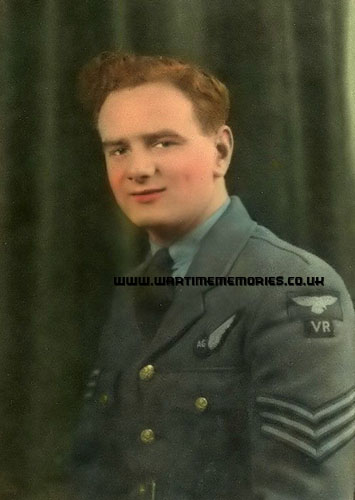 On the 24th/25th April 1944, P/O Dibbins and the rest of his crew climbed aboard Halifax III LK789 MP-L of No. 76 Squadron for the last time. Having just completed a briefing, the target that night was Karlsruhe, situated in southwest Germany. This was the crew’s 18th operation.
At 22.09 hrs the bomber took off from RAF Holme-on-Spaulding Moor, Yorkshire. According to reports, bombing was scattered due to heavy cloud and a stronger than forecast wind, which pushed the Pathfinders off track. Flak was moderate and ineffective and, over the target area at least, no night fighters were encountered. However, on returning to friendly territory, the bombers were routed ‘up England’ and, due to the very real risk of collision, many flew with navigation lights on, having been briefed that no intruder activity was expected. This was not the case, as Halifax LK789 was engaged and shot down 20 km northeast of Cambridge by a Me410 flown by Leutnant Wolfgang Wenning of II./KG51. The bomber crashed in a field opposite Colony Farm near Welney, Norfolk, after the pilot tried to crash land. All of the crew, with the exception of the rear gunner, were killed. My uncle, Norris Harrison, known as Mervyn, was the mid-upper gunner on the aircraft and was just 19 years old when he lost his life.
Crew:
- P/O. D.R Dibbins, Pilot RAFVR, age 21, killed
- Sgt. G.J Head, Fl/Engineer RAFVR, age 20, killed
- Sgt. K.C Oswald, Navigator RAFVR, age 22, killed
- F/Sgt. J.R Bathe, Bomb Aimer RAFVR, age 30, killed
- Sgt. J.G Davenport, W/Op/AG RAFVR, age 21, killed
- Sgt. N.M Harrison, Air Gunner RAFVR, age 19, killed
- F/Sgt. J. Anderson, Air Gunner RAFVR age 20, injured (he was rushed to RAF Ely hospital with a fractured femur and head injuries)
|
F/Sgt. Geoffrey William "Gerry" Vines DFM. 76 Squadron Geoffrey Vines was a rear gunner in 76 squadron during the 2nd World War based at Holme on Spalding Moor.
He is currently living in Taunton Somerset at the age of 96
|
Recomended Reading.Available at discounted prices.
|
|
|









